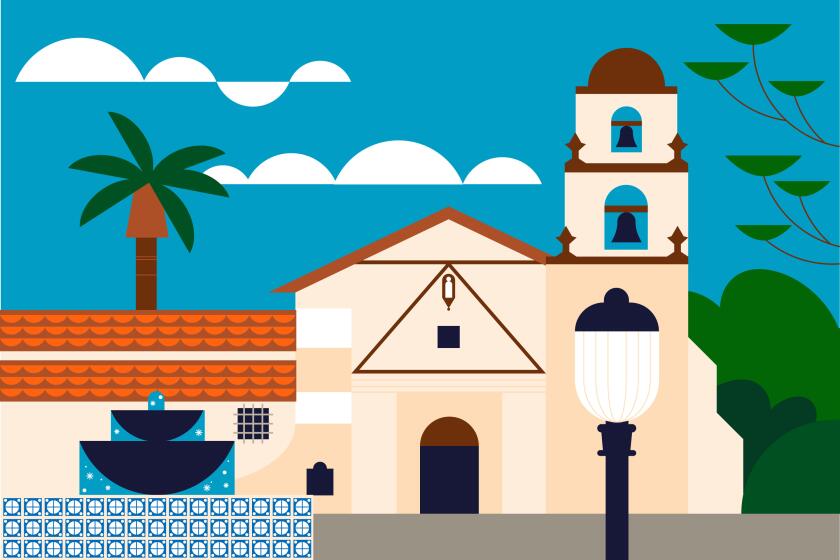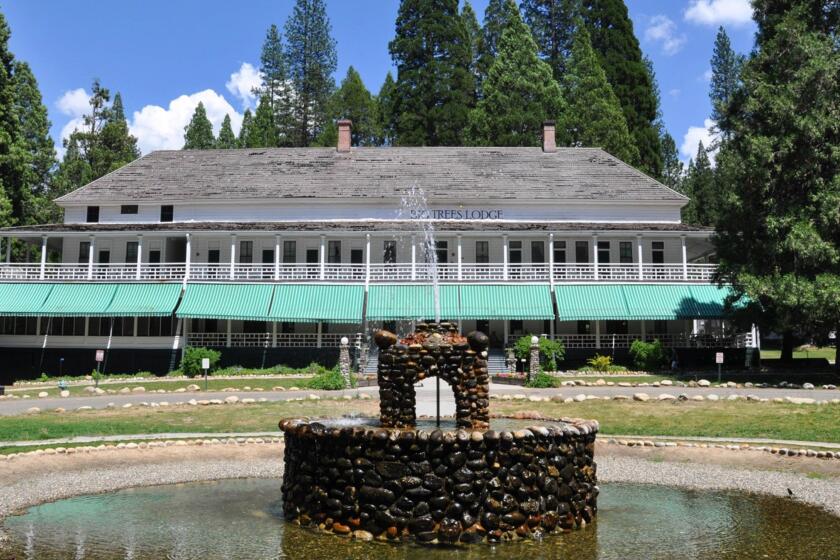His Home on the Range : At Will Rogers State Historical Park, the cowboy philosopher’s charm and way of life are preserved.
On a hill two miles from the ocean, you see the sun shimmering on the water behind the white sweep of surf. To the south, Santa Monica is a toy town with tiny cars darting among the dollhouses. To the east, Century City’s towers reach toward the clouds.
Far below, at your feet, is the 31-room ranch house that humorist Will Rogers called “the house that jokes built.” Preserved as a state park, it’s a living memorial to America’s first mass-media star. Its 186 acres of wide-open spaces are an inviting place for a picnic, a hike up the hill and a chance to revisit the life and career of the cowboy philosopher.
Will Rogers captured the hearts and minds of his countrymen as no one quite had before--or since. He was a star of stage, screen and radio. His daily column of wry political commentary was syndicated by more than 400 newspapers, and until last spring was reprinted in 183 of them.
His words evinced a common-sense populism that still rings true for many. A new collection of his writings and utterances, “Will Rogers Speaks,” will be published in March by M. Evans & Co Inc. It is the ninth book about Rogers to come out within three years. A new TV documentary of his life debuted in December. A recent New York Times story began with his quote: “I don’t belong to any organized political party--I’m a Democrat.”
Rogers’ charisma was obvious to all he encountered. Eighty-three-year-old Aaron Rothenberg of Brentwood, a retired businessman, recalls meeting Rogers at Pasadena Junior College about 1929. In 1932, the two met again when Rothenberg was selling programs at the Olympic equestrian events in Brentwood. “I was just a kid, but he took time to talk to me about his world travels,” Rothenberg said. “He became something of a role model. I’ll never forget him.’
Rogers died in a plane crash in Alaska in 1935, but the rangers and volunteers who show visitors around the ranch say they still feel his presence. The head of docents, Gene Asanovich of Woodland Hills, says: “We hear footsteps upstairs when the house is empty.”
And so he beckons.
2 p.m: We pull into the parking lot smack between two polo fields. The Will Rogers Polo Club plays public matches here on weekends, starting May 6. Rogers’ love of polo was rooted in his prairie upbringing. Born one-quarter Cherokee in 1879 in Indian territory that is now Oklahoma, he was raised on a cattle ranch and took to cowboy ways as soon as he could walk.
Up a flight of stone steps in the visitor center, a 12-minute film biography is shown throughout the day.
Young Rogers took his lariat and rode off to join Wild West shows popular at the turn of the century. His fancy rope tricks led to the vaudeville stage, and gradually he spiced up his act with homespun jokes and deadeye political commentary. He became the toast of Broadway, starring in the Ziegfeld Follies.
In Hollywood, he became the No. 1 box office star of 1932. It seemed that all of America tuned in to his Sunday evening radio show. He wrote six books and went around the world, raising money for victims of floods, earthquakes and hunger.
Included in the movie are scenes from “The Ropin’ Fool,” a 1921 two-reel silent film that displays many of Rogers’ spectacular lariat tricks. Visitors watching the film gasp appreciatively.
2:30 p.m.: Paying the $5 parking fee, we pick up special portable radios for a self-guided tour of the grounds and, in the small gift shop, browse among dozens of books by and about Will Rogers. There are also toy lariats and rope-trick books and racks of postcards.
We select a videocassette that includes “The Ropin’ Fool” and director John Ford’s “Judge Priest,” widely regarded as Rogers’ best movie performance.
3 p.m.: Tours of the house are conducted daily from 10:30 a.m. to 4:30 p.m. On this day, park interpreter Michael Allan welcomes visitors.
Rogers came to Hollywood in 1919, bought the ranch for polo and trail riding, and built the house in 1924 for his family--wife Betty and children Will Jr., Jim and Mary. Rustic and spacious, the house embraced the young family, and photos in the visitors center show them--Mom and Dad, the handsome boys and the pretty daughter--on polo ponies, relaxing around the house and playing with their animals.
Will was living here at the time of his death. Of the immediate family, only Jim is alive. At 79, the retired Bakersfield rancher makes several trips a year here, greeting visitors and reminiscing.
In a 1929 photo, the family is shown sitting around the living room, Mary cuddling her poodle, Jock, and Jim hugging his heifer, Sarah.
“She was our pet,” he said of the calf. “In those days, the front yard was fenced in as a pasture, and that’s where we kept her. We’d ride around on her and rope her. But we didn’t let her in too often.”
The house remains unchanged since being deeded to the state upon Betty Rogers’ death in 1944.
The living room is vast and packed with Will’s mementos: lariats, saddles, branding irons, spurs, chaps, Navajo rugs, keys to cities. There are numerous original paintings and drawings by the Western artists Ed Borein and Charles M. Russell--both friends of Rogers.
A favorite is a stuffed calf Borein gave Rogers to rope--and to show he was wearying of his host’s habit of lassoing visitors as they stepped out of the car.
Upstairs in the study is Rogers’ desk and typewriter. A picture window overlooks the barn.
3:30 p.m.: Outside again, in surroundings that many couples have used to exchange wedding vows, a short stroll uphill brings us to Rogers’ barn. He found it in the San Fernando Valley, near Coldwater Canyon Road, Jim recalled, and had it moved here.
Today the equestrian center provides riding lessons and stabling, for a fee. It is not unusual to glimpse movie stars who keep their animals here.
4 p.m.: We save the hike for last, allowing at least an hour to ascend, enjoy the view--city lights wink on as the sun sets--and return. The mile-long trail to Inspiration Point, at 763 feet elevation, was Rogers’ favorite, Jim said.
Up here, Rogers looked out at the ocean. It was as far west as he would go. He wrote that someday he would return to Oklahoma and live out his days on the top of a hill. He’s buried there now, but his work is alive. The books are still being published, the movies still shown, and back down there in the ranch house, there are those footsteps.
(BEGIN TEXT OF INFOBOX / INFOGRAPHIC)
WHERE AND WHEN
What: Will Rogers State Historical Park.
Location: 1501 Will Rogers State Park Road, Pacific Palisades.
Hours: 8 a.m. to 6 p.m. daily. House tours hourly from 10:30 a.m. to 4:30 p.m.
Price: $5 daily parking fee.
Call: (310) 454-8212.
Sign up for The Wild
We’ll help you find the best places to hike, bike and run, as well as the perfect silent spots for meditation and yoga.
You may occasionally receive promotional content from the Los Angeles Times.



